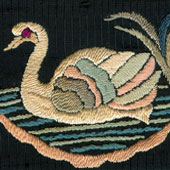The first wave of migrants from Iran was of farmers and although they branched into trades and businesses in their host country, the Parsis remained bonded to their agrarian roots. Therefore it is only natural; that they should find symbols and icons that reminded them of these agrarian roots, attractive in the Chinese embroidery rendered in their garments. Lily ponds, hens with chicks, ducks, roosters, creepers and vines, floral sprays and horse carts are both popular and recurring motifs in Parsi saris and borders. Goldfish and carp are two symbols that are representative of plenty and fertility for the Parsis. The silver tray that one sees in every Parsi home holding a lamp, rose water, a cone shaped vessel also includes a silver fish rendered in great detail. It is this same detailed rendering that one sees in the borders. Pheasants and phoenix also form a part of the repertoire of popular and recurring motifs in Parsi embroidery on borders. The mythical phoenix referred to as the “shahmrug” or royal rooster is a recurring motif in many ancient stories and myths told and retold in the Middle Eastern region as well as in China.
It is interesting to note that in this geographical region the phoenix is not the mythical bird that rises from the ashes but is a bird that is a harbinger of good fortune and good tidings. In the popular story dedicated to Mushkel Aasan Behram Yazd; for example, it is the phoenix that saves the protagonist and his family from ruin and a sullied reputation. Peacocks are also recurring popular motifs in borders. This may be the result of the influence of peacocks rendered in Indian embroidery and iconography related to the worship of Lord Krishna in the Indian pantheon. Roses, daisies, floral wreaths and floral sprays may have been an influence of English embroidery on lace tablecloths, doilies, table runners and curtains imported and in use by the British in India. Braided borders were also quite popular as they were easy to make since the Chinese were pioneers in braiding machines.


